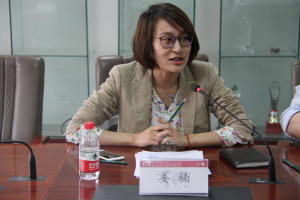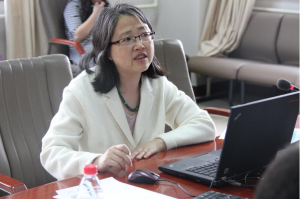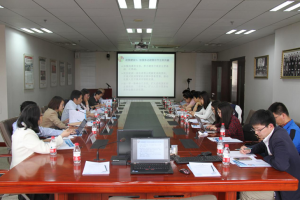Press Conference of Internationalization Progress and Outlook of RMB
2017-04-20 IMI Tu Yonghong, Deputy Director of IMI, gave a detailed interpretation of the report. Prof. Tu reviewed the annual reports in the past five years, and announced the restoration of quarterly reports in this year.
Tu Yonghong, Deputy Director of IMI, gave a detailed interpretation of the report. Prof. Tu reviewed the annual reports in the past five years, and announced the restoration of quarterly reports in this year.
 This report analyzed current trends of RMB internationalization from the perspective of international status. Recently, RMB internationalization ended the past 6-year of rapid progress, and entered into the adjustment phase. The main reasons are supply-side reform and a decreasing speed of economic growth, and RMB exchange rate reform and some unexpected international incidents, such as US election and Brexit, also played an important role.
The report analyzed the RII index. Because the released statistics has a lag, we used measured data in this report. The report predicts that, by the end of 2016, RII index would be 3.06; and by the end of 2017, it would be 3.08. Comparing to main currents internationalization, there is still certain gap. It is forecasted that the internationalization index of US dollar will continue to rise, and Euro will fall, and the British pound and Japanese yen will stay stable.
After that, the report analyzed the impetuses for RMB internationalization index to rise this year, including China’s economic stable growth will stimulate the newly formed impetus of new economic zones within SSR, so the economic development will be more stable; with China’s overseas investment exceeding the foreign capital that comes into China, the fast advancement of FDI will encourage the development of off-shore Renminbi market; the bonus of being included into SDR emerged, and RMB has become one of international safe assets providers; RMB exchange rate expectation is stable, which reassured market confidence; bond market continue to incorporate the international practice.
Meanwhile, the report mentioned three challenges face RMB internationalization in the future: first, the expectation of US dollar’s rise contributes to speculative capital outflow; second, the domestic bond market is not internationally competitive. Products lack abundance, and the market structure fail to satisfy international investors; third, because the divergences in developed countries are obvious, dollars increases interest rate, but Europe and Japan are still engaged in QE, thus China will have more difficulty coordinate with international policies.
The report concluded that we should face the challenge, push forward RMB internationalization. Facing these risks, first we need to practice precise capital flow management system, avoid common methods for different situations, and support corporate and individual investment and trades that abide by laws and regulations. We should also strengthen bonds as international safe assets, expanding the two-way openness, and encourage assets securitization to satisfy global investors. Last, we should enhance multilateral policy cooperation, win-win cooperation, and avoid trade friction.
This report analyzed current trends of RMB internationalization from the perspective of international status. Recently, RMB internationalization ended the past 6-year of rapid progress, and entered into the adjustment phase. The main reasons are supply-side reform and a decreasing speed of economic growth, and RMB exchange rate reform and some unexpected international incidents, such as US election and Brexit, also played an important role.
The report analyzed the RII index. Because the released statistics has a lag, we used measured data in this report. The report predicts that, by the end of 2016, RII index would be 3.06; and by the end of 2017, it would be 3.08. Comparing to main currents internationalization, there is still certain gap. It is forecasted that the internationalization index of US dollar will continue to rise, and Euro will fall, and the British pound and Japanese yen will stay stable.
After that, the report analyzed the impetuses for RMB internationalization index to rise this year, including China’s economic stable growth will stimulate the newly formed impetus of new economic zones within SSR, so the economic development will be more stable; with China’s overseas investment exceeding the foreign capital that comes into China, the fast advancement of FDI will encourage the development of off-shore Renminbi market; the bonus of being included into SDR emerged, and RMB has become one of international safe assets providers; RMB exchange rate expectation is stable, which reassured market confidence; bond market continue to incorporate the international practice.
Meanwhile, the report mentioned three challenges face RMB internationalization in the future: first, the expectation of US dollar’s rise contributes to speculative capital outflow; second, the domestic bond market is not internationally competitive. Products lack abundance, and the market structure fail to satisfy international investors; third, because the divergences in developed countries are obvious, dollars increases interest rate, but Europe and Japan are still engaged in QE, thus China will have more difficulty coordinate with international policies.
The report concluded that we should face the challenge, push forward RMB internationalization. Facing these risks, first we need to practice precise capital flow management system, avoid common methods for different situations, and support corporate and individual investment and trades that abide by laws and regulations. We should also strengthen bonds as international safe assets, expanding the two-way openness, and encourage assets securitization to satisfy global investors. Last, we should enhance multilateral policy cooperation, win-win cooperation, and avoid trade friction.

